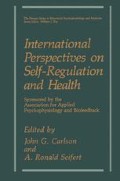Abstract
Table 1, compiled from our review of the immunoconditioning literature (Kusnecov, King, & Husband, 1989b), summarizes studies reported subsequent to Ader and Cohen’s (1975) important observation of behaviorally conditioned immunosuppression using a taste aversion procedure. The summary is further confined to studies that have used drugs or biological substances as the UCS. Even within this homogeneous operational set there is evident a variety of relationships between the behavioral conditioning paradigm, predominantly taste aversion conditioning (CTA), and the concomitant immunoconditioning.
Access this chapter
Tax calculation will be finalised at checkout
Purchases are for personal use only
Preview
Unable to display preview. Download preview PDF.
References
Ader, R. (Ed.). (1981). Psychoneuroimmunology. New York: Academic Press.
Ader, R., & Cohen, N. (1975). Behaviorally conditioned immunosuppression. Psychosomatic Medicine, 37, 333–340.
Ader, R., & Cohen, N. (1982). Behaviorally conditioned immunosuppression and murine systemic lupus erythematosous. Science, 215, 1534–1536.
Fudenberg, H. H., & Wybran, J. (1982). Experimental immunotherapy. In D. P. Stites, J. D. Stobo, H. H. Fudenberg, & J. V. Wells (Eds.), Basic and clinical immunology (4th ed.). Los Altos, CA: Medical Publications.
Gamzu, E. (1977). The multifaceted nature of taste-aversion-inducing agents: Is there a single common factor? In L. M. Barker, M. R. Best, & M. Domjan (Eds.), Learning mechanisms in food selection. Waco, TX: Baylor University Press.
Ghanta, V. K., Hiramoto, R. N., Solvason, H. B., & Spector, N. H. (1985). Neural and environmental influences on neoplasia and conditioning of NK activity. Journal of Immunology, 135 (Suppl.), 848–852.
Husband, A. J., King, M. G., & Brown, R. (1986/1987). Behaviorally conditioned modification of T cell subset ratios in rats. Immunology Letters, 14, 91–94.
King, M. G., Husband, A. J., & Kusnecov, A. W. (1987a). Behavioural conditioning of the immune system: From laboratory to clinical application. In J. L. Sheppard (Ed.), Advances in behavioural medicine (Vol. 4). Sydney, Australia: Cumberland College Press.
King, M. G., Husband, A. J., & Kusnecov, A. W. (1987b). Behaviorally conditioned immu-nosuppression using antilymphocyte serum: Duration of effect and role of corticosteroids. Medical Science Research, 15, 407–408.
Kusnecov, A. W., King, M. G., & Husband, A. J. (1989). Immunomodulation by behavioral conditioning. Biological Psychology, 28, 25–39.
Kusnecov, A. W., Sivyer, M., King, M. G., Husband, A. J., Cripps, A. W., & Clancy, R. L. (1983). Behaviorally conditioned suppression of the immune response by antilymphocyte serum. Journal of Immunology, 130, 2117–2120.
Kusnecov, A. W., Husband, A. J., Pang, G., Smith, R., & King, M. G. (1987). In vivo effects of beta-endorphin on lymphocyte proliferation and I1-2 production. Brain Behavior and Immunity, 2, 88–97.
Kusnecov, A. W., Husband, A. J., & King, M. G. (in press). The influence of dexamethazone on behaviorally conditioned immunomodulation and plasma corticosterone. Brain Behavior and Immunity.
Russell, M., Dark, K. A., Cummins, R. W., Ellman, G., Gallaway, G., & Peeke, H. V. S. (1984). Learned histamine release. Science, 225, 733–734.
Sivyer, M., King, M. G., Husband, A. J., Cripps, A. W., & Clancy, R. L. (1982). Antilymphocyte serum produces conditioned taste aversion in rats. IRCS Medical Science, 10, 553.
Yahaya, Mahamood, & King, M. G. (1985). Extinction of a partially reinforced free operant behaviour: A comparison of methods of food withdrawal and their biochemical consequences. Sains Malaysiana, 14, 385–397.
Author information
Authors and Affiliations
Editor information
Editors and Affiliations
Rights and permissions
Copyright information
© 1991 Springer Science+Business Media New York
About this chapter
Cite this chapter
King, M.G., Husband, A.J. (1991). Altered Immunity through Behavioral Conditioning. In: Carlson, J.G., Seifert, A.R. (eds) International Perspectives on Self-Regulation and Health. The Springer Series in Behavioral Psychophysiology and Medicine. Springer, Boston, MA. https://doi.org/10.1007/978-1-4899-2596-1_11
Download citation
DOI: https://doi.org/10.1007/978-1-4899-2596-1_11
Publisher Name: Springer, Boston, MA
Print ISBN: 978-1-4899-2598-5
Online ISBN: 978-1-4899-2596-1
eBook Packages: Springer Book Archive

